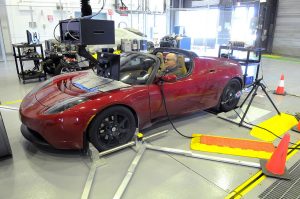
Attesa is being planned to provide one-stop R&D for vehicle manufacturers. We expect test drivers to be our biggest fans.
Last June, three-time Formula 1 racing Champion Lewis Hamilton shared his opinions about vehicle development and testing in an article posted on autosport.com. Regarding simulators, he said they were much more important to the engineers than the driver, adding the difference between driving a simulator and driving a real race car was emotion.
“When you get into the simulator you have to adjust yourself to the simulator, and when you get in the car you don’t adjust to it, you drive. In the simulator, you have to adjust all your feelings – you don’t get the same movements, the same bumps.”
Simply put, the sensations of driving a real race car at speed, including the risks, mental and physical strain, and emotion, cannot be replicated.
Hence the importance and value of having a racing circuit at the same place as the computers, simulators, engineers and fabricators.
Which is the rationale behind the concept of Attesa, the transportation technology community coming to Pinal County, Arizona.
Some background: In the mid 1950’s the study of vehicle dynamics began to follow the lead of aeronautical engineering, using mathematics to improve the breed. They used slide rules back then but the results were undeniable; one famous example being the success of the original Chaparral race cars in the 60’s thanks to an unofficial tech collaboration with Chevrolet.
‘Modeling’ allowed engineers to create prototypes used to test their mathematical theories. But it was the availability of digital computing, including both hardware and software, that advanced vehicle dynamics toward where it is today.
Computer modeling let engineers study how loads and forces, distributed throughout mechanical systems, would impact the vehicle they were planning to produce — for street, track or both.
Next came simulators, a new step between modeling and the reality of prototypes. Simulators facilitated a closer relationship between the design and engineering staff and drivers. McLaren is usually credited with starting the trend in the late 90’s, eventually being able to develop and ‘test’ a new Formula 1 car a full year before it was actually built and ready to run.
Today the computers, modeling software and simulators have advanced to levels of unprecedented accuracy and efficiency. Every automaker in the world uses this technology to develop, build and sell road and race vehicles that are an improvement on what they built before.
But they still need to actually test, in real world environments, on private circuits that allow cars, trucks and even motorcycles to prove or deny what the modeling and simulations tell the engineers.
Attesa is going to be a place where manufacturers, specialty vehicle providers and race car companies can conceive, model, create and test without ever having to load up a transporter.
The commerce park will feature structures and facilities that can house designers and engineering departments, including the most advanced technology tools, toys and simulators.
It will have through-the-gate access to a 2.8-mile, FIA 2 certified circuit specifically created to stress steering, brake, suspension, engine and drivetrain components. And with central Arizona’s balmy weather (average high, 86.4 degrees Fahrenheit; average low 54.2 degrees; annual average temperature, 70.3 degrees), Attesa will always be open for business.
Attesa. Soon to be America’s one-stop headquarters for vehicle research, development and track testing.
